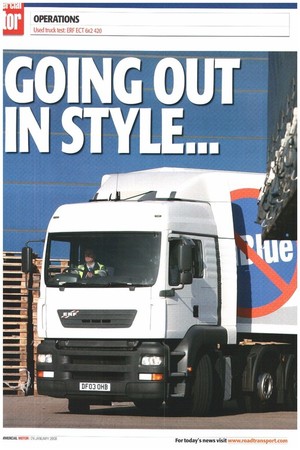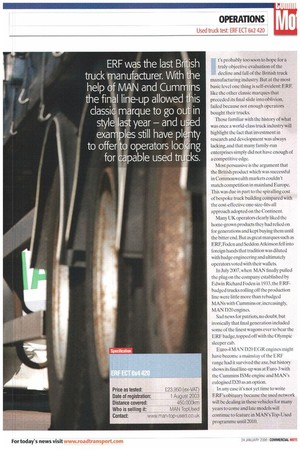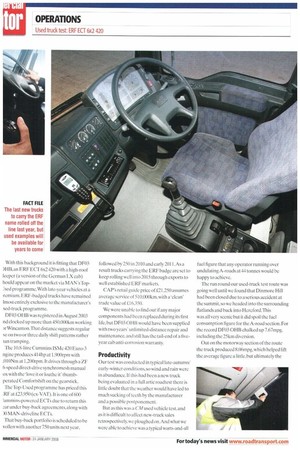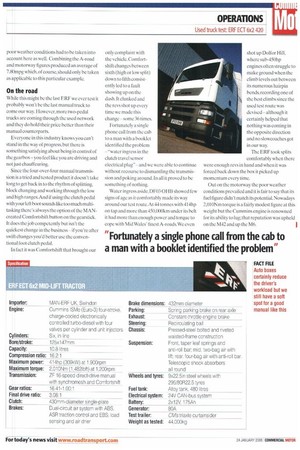GOING OUT
Page 32

Page 33

Page 34

Page 35

If you've noticed an error in this article please click here to report it so we can fix it.
ERF was the last British truck manufacturer. With the help of IVAN and Cummins the final line-up allowed this classic marque to go out in style last year — and used examples still have plqnty to offer to operators looking for capable used tr ks.
t's probably too soon to hope for a truly objective evaluation of the decline and fall of the British truck manufacturing industry. But at the most basic level one thing is self-evident: ERF, like the other classic Marques that preceded its final slide into oblivion, failed because not enough operators bought their trucks.
Those familiar with the history of what was once a world-class truck industry will highlight the fact that investment in research and development was always lacking, and that many family-run enterprises simply did not have enough of a competitive edge.
Most persuasive is the argument that the British product which was successful in Commonwealth markets couldn't match competition in mainland Europe. This was due in part to the spiralling cost of bespoke truck building compared with the cost-effective one-size-fits-all approach adopted on the Continent.
Many UK operators clearly liked the home-grown products they had relied on for generations and kept buying them until the bitter end. But as great marques such as ERF, Foden and Seddon Atkinson fell into foreign hands that tradition was diluted with badge engineering and ultimately operators voted with their wallets.
In July 2007, when MAN finally pulled the plug on the company established by Edwin Richard Foden in 1933, the ERFbadged trucks rolling off the production line were little more than rebadged MANs with Cummins or, increasingly, MAN D20 engines.
Sad news for patriots, no doubt, but ironically that final generation included some of the finest wagons ever to bear the ERF badge, topped off with the Olympic sleeper cab.
Euro-4 MAN D20 EGR engines might have become a mainstay of the ERF range had it survived the axe, but history shows its final line-up was at Euro-3 with the Cummins ISMe engine and MAN's eulogised D20 as an option.
In any case it's not yet time to write ERF's obituary because the used network will be dealing in these vehicles for many years to come and late models will continue to feature in MAN's Top-Used programme until 2010. With this background it is fitting that DF03 )HB, an ERF ET 6x2 420 with a high-roof leeper version of the German LX cab) hould appear on the market via MAN's Topised programme.With late-year vehicles at a rem inn). ERF-badged trucks have remained [most entirely exclusive to the manufacturer's sed-truck programme.
DF03 OHB was registered in August 2003 nd clocked up more than 450.000km working )r Wincanton.That distance suggests regular se on two or three daily shift patterns rather tan tramping.
The 10.8-litre Cummins ISMe 420 Euro-3 ngine produces 414hp at 1.900rpm with ,010Nm at 1 .20Orpm. It drives through a ZF 6-speed direct-drive synchromesh manual ox with the 'love it or loathe it thumbperated Comfortshift on the gearstick. The Top-Used programme has priced this RF at £23,950 (ex-VAT). It is one of 600 !ummins-powered ECTs due to return this car under buy-back agreements, along with )0 MAN-drivcline FCTs.
That buy-back portfolio is scheduled to be vollen with another 750 units next year, followed by 250 in 2010 and early 2011.As a result trucks carrying the ERF badge are set to keep rolling well into 2015 through exports to well established ERF markets.
CAP's retail guide price of £21,250 assumes average service of 510,000km. with a 'clean' trade value of £16,350.
We were unable to find out if any major components had been replaced during its first life,but DF03 OH B would have been supplied with two years' unlimited-distance repair and maintenance. and still has the tail-end of a fiveyear cab anti-corrosion warranty.
Productivity
Our test was conducted in typical late-autumn/ early-winter conditions,so wind and rain were in abundance. If this had been a new truck being evaluated in a full artic roadtest there is little doubt that the weather would have led to much sucking of teeth by the manufacturer and a possible postponement.
But as this was a CM used vehicle test. and as it is difficult to affect new-truck sales retrospectively. we ploughed on.And what we were able to achieve was a typical warts-and-all fuel figure that any operator running over undulating A-roads at 44 tonnes would be happy to achieve.
"The run round our used-truck test route was going well until we found that Dinmore Hill had been closed due to a serious accident at the summit, so we headed into the surrounding flatlands and back into Hercford.This was all very scenic but it did spoil the fuel consumption figure for the A-road section. For the record DF03 OHB chalked up 7.67mpg, including the 25km diversion.
Out on the motorway section of the route the truck produced 8.06rnpg, which helped lift the average figure a little, but ultimately the poor weather conditions had to be taken into account here as well. Combining the A-road and motorway figures produced an average of 7.80mpg which, of course, should only be taken as applicable to this particular example.
On the road
While this might he the last ERF we ever test it probably won't be the last manual truck to come our way. However, more two-pedal trucks are coming through the used network and they do hold their price better than their manual counterparts.
Everyone in this industry knows you can't stand in the way of progress, but there is something satisfying about being in control of the gearbox-you feel like you are driving and not just chauffeuring.
Since the four-over-four manual transmission is a tried and tested product it doesn't take long to get back in to the rhythm of splitting, block changing and working through the low and high ranges. And if using the clutch pedal with your left boot sounds like too much multitasking there's always the option of the MANcreated Comfortshift button on the gearstick. It does the job competently hut isn't the quickest change in the business if you're after swift changes you'd better use the conventional foot clutch pedal.
In fact it was Cornfortshift that brought our only complaint with the vehicle. Comfortshift changes between sixth (high or low split) down to fifth consistently led to a fault showing up on the dash. it clunked and the revs shot up even: time we made this change some 36 times.
Fortunately a single phone call from the cab to a man with a booklet identified the problem -"water ingress in the clutch travel sensor electrical plug"-and we were able to continue without recourse to dismantling the transmission and poking around. In all it proved lobe something of nothing.
Water ingress aside, DF03 OHB showed few signs of age as it comfortably made its way around our test route.At 44 tonnes with 414hp on tap and more than 450,000km under its belt it had more than enough power and torque to cope with Mid Wales' finest A-roads.We even shot up Dolfor Hill, where sub-450hp engines often struggle to make ground when the climb levels out between its numerous hairpin bends, recording one of the best climbs since the used test route was devisedalthough it certainly helped that nothing was coming in the opposite direction and no slowcoaches got in our way.
The ERF took splits comfortably when there were enough revs in hand and when it was forced back down the box it picked up momentum every time.
Out on the motorway the poor weather conditions prevailed and it is fair to say that its fuel figure didn't match its potential. Nowadays 2,0101\ m torque is a fairly modest figure at this weight but the Cummins engine is renowned for its ability to lug; that reputation was upheld on the M42 and up the Mh.








































































































































































